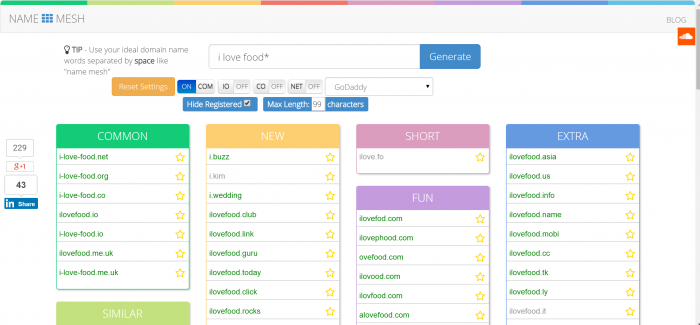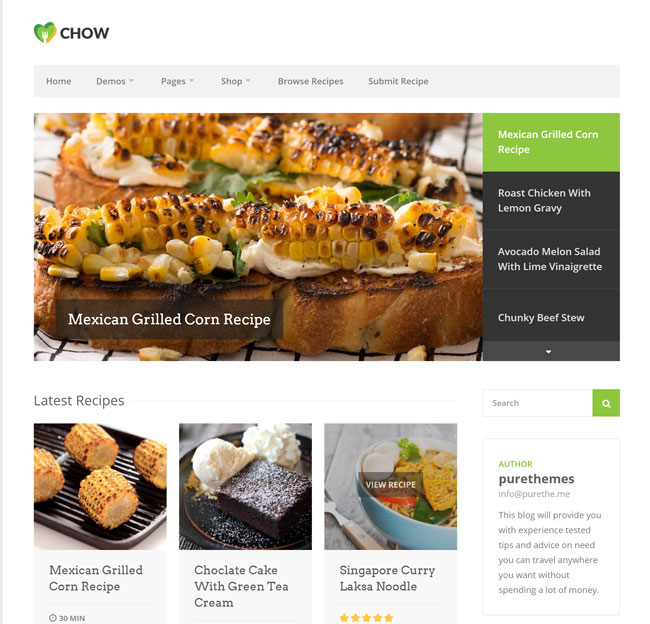
A Step-by-Step Recipe For Starting A Delicious Food Blog
Have you ever cooked a dish so good that after you were done eating you just had to tell someone about it? Thankfully for you, the internet is rife with users who are just dying to see the stuff that you’ve been cooking.
Nowadays, it is easier than ever to start your very own food blog, but that doesn’t mean that it is a piece of cake. Don’t worry, though, with a little hard work, elbow grease, and this step by step guide on how to start your own food blog, you’ll be well on your way to cooking delicious food, snapping mouth-watering photos, and sharing it with the masses. Bon appetite!
Let’s break it down into phases:
Appetizer: The basics
A food blog, like any other endeavour you undertake on the net, is going to require a few basic things to get off the ground:
A Website

First things first, you are going to need to get yourself at least a basic website. I personally prefer the self hosted WordPress platform for a few reasons. First off, WordPress is free (all you need to do is pay for hosting and a domain), and that’s always nice, but on top of that it is relatively easy to use with little to no experience, it’s also what we use here on Outsprung.
Come up with a catchy name
Never hurts to go with some delicious wordplay, so don’t skimp on the cheesy food innuendo in your title (see what I did there?). This can take some time so don’t rush it. We spent over 10 hours brainstorming till we came up with Outsprung.

Namemesh is a great little tool that will search for all the possibilities for your chosen keywords. Not only that but it shows only the domains that are available so you don’t have to go through the painstakingly slow process of searching each individual domains availability.
The Design
Go with a plain and simple, bread & butter theme so that it is both visually pleasing and non-obstructive. These can range anywhere from free to around $150. It’s up to you. A good place to start looking for a theme is Themeforest. Chow is a great example of a food blog theme, just take a look at the screenshot below.

If you have a little extra scratch to play around with, you can hire a company or freelancer to build and design your site. I prefer the latter because they will often offer a more personal service. Ask around to see if any of your friends can recommend someone. If not, try Elance.com, Upwork.com, or Freelancer.com. You’ll have a slew of candidates to choose from.
A domain and hosting
If building a website were building a house, then the domain and hosting are like the property and address. What good is a house if you can’t put it somewhere, and people can’t find it.
There are a lot of great companies out there that offer packages, and I’ve had good experiences with SiteGround. Make sure you google “promo codes” for the website beforehand. You can often save 10% or more. What makes SiteGround so good is that they are both affordable, and they have a specific hosting packages for WordPress blogs.
A few pages and plugins
This may seem complicated at first, but thankfully WordPress makes this easy. To add some basic pages go to the dashboard > pages > add new, title the page and put some content, then hit publish. It’s really that easy. Check out the video below if you get stuck.
Be sure to have an about me page with a photo, people love that stuff. It endears them to you and puts a face to your blog. From there you need to download two things: the SEO plugin, and social sharing plugin. These will allow you to rank better in the search engines, and give your audience an easy click-to-share option to get you some buzz on social media.
I know this can seem daunting at first, but don’t worry. It can take only a few hours if done right. Here is a step-by-step tutorial on youtube to help you along.
The Main Course: Finding an identity
Now that you’ve got your beautiful new website up and running, a unique name and address, and a bunch of beautiful pages it’s time to get to the meat and potatoes of it all (I’m noticing a pattern here).
If you’re going to stand out, and climb the ranks all the way to a wealthy, professional passive-income-earning blogger, you’re going to need a unique angle and personality. Let’s look at a few things you should do:
Research.Research.
Go to Google, and type in “food blogs”, see what comes up. Open up the first 20 results and answer these research questions for each site. From here we’ll have a better understanding of what readers expect and how we can maybe approach food blogging to give you an edge.
- What topics are they writing about?
- Average article length?
- What blog post titles caught your eye?
- Are they active on social media, if so which ones?
- How often are they posting?
- How much photography are they using?
They say that sports are copycat games. When a team is successful with a strategy, everyone jumps on the bandwagon. Well, doing that in other fields is fine too.
Download Our Article Checklist
Make sure every article you post is at the top of it's game with our article checklist. Be sure to print it out and stick it on your wall as this is something you'll want to be using for everything you write.
Identify your personality and run with it
Taking some cues from the competition is a great way to get the pot boiling, but it isn’t going to add that great flavour that your blog needs to get on everyone’s dinner table.
Are you going to be that sweet old Indonesian lady that reminds every one of their grandma, and so lovingly stirs up a beautiful dish with succulent curry spices that gets your mouth watering instantly (can you tell I watch food vlogs)?

Think a unique angle and personality doesn’t sell? Think again. One need only take a look at Vegan Black Metal Chef, to see the power of having a gimmick.
Are you going to be a health food blog? An eat-like-a-man blog? An Asian fusion blog? Studies have shown that blogs with a theme that stick to it regularly drive the most traffic and visitor loyalty. Take advantage of this.
Decide on a posting frequency
Don’t overdo it. Something every day is too much. Once a week may not be enough. Find the sweet spot. I would try to find some gimmicks and angles here too.
For instance, why not have a “couple’s Thursday” or “lazy Sunday health food” post each week? It will help people remember you, and give them a reason to keep coming back. Take inspiration from vegetarianmamma.com, every Friday they feature a gluten free recipe to their readers.

Twice a week should be a good amount of posts, but mix it up a bit. This could be a good time to scope out the competition and see what their recipe for success is.
Once you have got the website all set up, made your pages, and come up with a theme and some gimmicks, we can move on to phase three: Expansion.
Dessert: Expand
Most people would be satisfied with themselves for getting this far. I mean, you have built yourself a nice webpage, identified a theme, scoped out the competition and modified your very own blog to fit your needs and interests. You should be proud.
But pride isn’t enough for you, you want to be heard. You want to rise up the ranks, and conquer the food blogging world! The final course, the dessert if you will of the whole operation will be to expand your blog and get your name on dinner tables across America.
Network
Networking is key to most things in life, but when it comes to blogging, it is paramount. Start with people in your own network like friends and family. Ask them to subscribe to your blog, share posts, and even make your recipes and share pictures.
From there, you need to turn to other bloggers. The writing community is more dependent on itself than any other industry when it comes to monetizing yourself. I recommend starting here.
This will give you some great communities to help get your name in the game. You never when someone is going to know someone who has a local restaurant and wants to try something that you’ve made, or when a friend might put your blog up on their website. Nothing wrong with a putting a little sweat into your recipes (figuratively. Absolutely figuratively).
Guest Blog
This goes hand-in-hand with networking, but much like the olive oil that goes with your bread, it is so important that it deserves its own plate.
In the old fashioned world, you had to go out directly to people and ask for jobs. Nikola Tesla invented alternating current, hopped on a boat, and showed it right to Edison’s face. Do you think he got the job?
The world of the internet, isn’t as different as you might think. I would start by making a list of at least 20 similar food blogs, and contact them directly. David Schneider wrote an excellent guide on how he got his first 400 leads using a similar method.
Email them some of your work, with links to your posts and ask to make a guest post. Follow them on Facebook, tweet at them, like their Pinterest pictures, and see if they are on Linkedin (remember all of these names).
Chances are only a few will respond, but sometimes all you need is that one good spice to make a great soup. Know what I mean?
A great resource on finding guest post opportunities can be found: http://www.socialmediaexaminer.com/guest-blogging-communities/
Social Media
Think of your beautiful blog as pot full of delicious stew. In order to stir this delicious concoction, you need a ladle, a serving spoon, some dishes, and utensils. The equivalent for you here is social media.
There is no other way to reach such a vast audience for next to nothing but your time. The first place to go is mighty Facebook. Simply create a page for your blog, build a profile, ask friends to like the page, and begin to share your recipes, articles, and photos on the site.
It is possible, but not necessary to advertise using Facebook. For how to do that, see here. It could be a good way to get new people to see your posts.
Not all social media is created equal, however. Since you will be dealing with food, you need to stick with the visual platforms. That’s where Pinterest comes in.
Posting beautiful pictures of your food will get people’s mouths watering, and they will be compelled to click through and see everything that you’ve made.
Be sure to follow influential users in your industry, re-pin what they put up, and try to interact with users as much as possible. If you have the time and drive, then I suggest this guide to getting better at growing via pinterest.
Growing a blog is as simple as being good at what you do, and working harder than everyone else to achieve. It’s being good at what you do that is the hard part.
Seeing as how you’ve made this far into the guide, though, I can tell you have what it takes to build a great food blog. This step-by-step recipe for a food blog will be enough to get your blog from the grocery store to your home, seasoned, prepared, and served onto your audience’s plates.
It’s up to you to make sure that is something they want to eat, and if they are going to come back for more.
Would you like to share your thoughts?
Your email address will not be published. Required fields are marked *